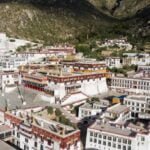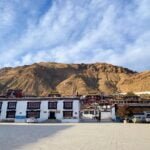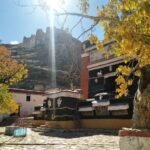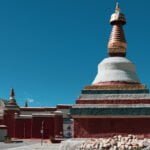About Sera Monastery
Sera Thekchen Ling Monastery, also known as Sera Monastery, is among the six primary monasteries of the Gelug Sect of Tibetan Buddhism. It is referred to as one of the three significant monasteries of Lhasa, along with Drepung Monastery and Ganden Monastery, and is the most recent one among them. Sera Monastery is a national key cultural relics site.
It is located at the foot of Sera Wuzi Mountain, about 3 kilometres north of Lhasa, and is surrounded by willow forests. Since ancient times, it has been a place where distinguished monks and living Buddhas deliver lectures. There are several small monasteries and nunneries in the vicinity, including Phurchok Monastery, Michung ri Nunnery, Gombasa Temple, Phabongkha Temple, Tashi Choeling Temple, Chubsang Temple, and Gari Nunnery, among others.
Behind the temple, there are Drubkhang Rito, Sera Choeding Temple, and other structures. Shakya Yeshi, who was one of Tsongkhapa‘s main disciples, constructed the monastery. Tsongkhapa was the founder of the Gelugpa School of Tibetan Buddhism. Although some people believe that the term Sera means “hailstone,” others believe it means “raspberry.”
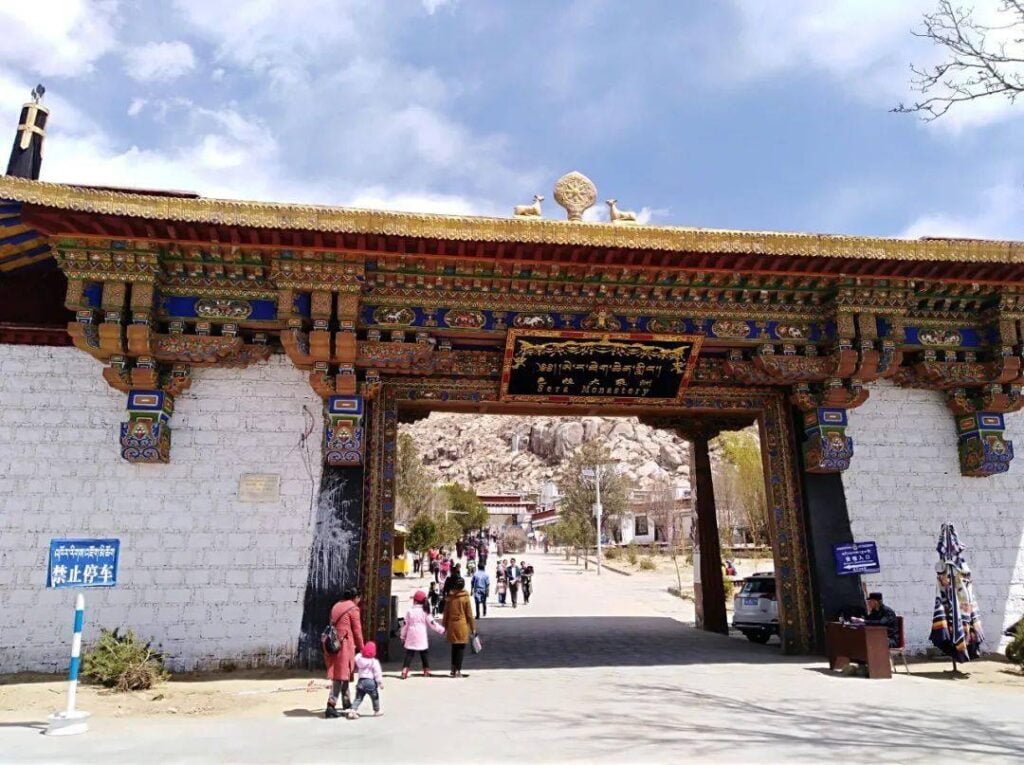
History of Sera Monastery
Jamchen Choejey, a disciple of Tsongkhapa, constructed the Sera Monastery in 1419, which was finished in 1434. Jamchen Choje was invited to Beijing and granted the title of Dharma King. Upon his return to Tibet, the temple housed the statues and scriptures, which still remain today. The monastery comprises three Dratsang: Je, Mey, and Ngaba and was home to over 8,000 monks at its peak, making it slightly smaller in scale than the Drepung Monastery.
The Sera Monastery is home to tens of thousands of Vajra Buddha statues, with most being crafted locally in Tibet. Additionally, there are numerous bronze Buddha statues that were brought from India or inland China. The four walls of the main hall and Dratsang sutra halls are adorned with countless original colour murals. The most renowned statue in the main hall is the “Horse-headed Buddha.”
The engraved version of “Kangyur” in 1410 within the Sera Monastery was the first Tibetan printed Tripitaka, bestowed by Emperor Yongle. The Sera Monastery encompasses Tsokchen Assembly Hall, Je Dratsang, May Dratsang, Ngaba Dratsang, and 32 Khangtsen. The earliest structures are Mey Dratsang and Ngaba Dratsang, with the current scale being the result of additions, repairs, and expansions throughout generations.
As a result, there is no overarching blueprint in the layout. Nevertheless, the Sera Monastery’s buildings are densely arranged, but not overcrowded, cluttered, or chaotic. It is adapted to local conditions and the main structure is prominent, reflecting the grand Gelugpa temple. It is a unique religious city with a distinctive style.
Building layout
Tsokchen Assembly Hall
The Tsokchen Assembly Hall serves as the primary hall of Sera Monastery, where the management of religious affairs is conducted. It was funded by Lhabsang Khan, a descendant of Gushi Khan, in 1710. Positioned in the northeast of Sera Monastery, the four-story structure encompasses the assembly hall and 5 Lhakang. The square outside the hall spans about 2,000 square meters and is paved with stone slabs. The sutra hall gate faces south, and the front profiles feature a double row of 10 pillars, with the four heavenly kings painted on the wall. The Assembly Hall has 89 long and 36 short pillars, covering almost 2,000 square meters. A long column supports a patio in the centre of the scripture hall for lighting.
After the passing of the seventh Dalai Lama, Kalsang Gyatso, a 5-meter-high gilt bronze statue of the Jampa Buddha was constructed on the east side. There are also statues of Gelugpa sect masters like Tsongkhapa, Gungru Gyaltsen Sangpo, Kunkhen Jangchub Bumba, and a Tomb stupa for various masters and scholars.
The gilt bronze statue of Jampa Buddha is beautifully crafted, sitting on a seat of two lions and bears, stepping on the lotus seat, and holding the wheel of the Dharma with both hands. Three temples are located behind the scripture hall, with Jampa Lhakang in the centre, and the main statue of the Tsokchen Hall inside. The statue is tall (about 6 meters), with the body on the first floor and the head on the second floor. The backlight of the Jampa Buddha’s face is made up of intricately carved Garuda, Dakhini, Naaga and more, with vivid images and fine carvings. On both sides of the Jampa Buddha statue, there are two coloured statues of the Eight Great Bodhisattvas and two statues of Wrathful deities.
On the tall scripture shelf next to the south wall, there is a collection of 105 volumes (originally 108 volumes) of Kagyur of Yongle (1410), that was presented to Jamchen Choeje Shakya by the Ming emperor.
In the centre of the hall stands a statue of Sakyamuni Buddha, while on either side are sixteen Arhats and the four heavenly kings, all of which are adorned with clay sculptures. Originally, the sixteen arhats were wooden statues brought by Jamchen Choeje Sakya Yeshi from the mainland. However, a clay sculpture was later added and the wooden statue was placed inside the clay statue’s belly. The statue maintains the style of Ming Dynasty statues.
On the east side of the Jampa Lhakhang is the Great Yamantaka Chapel (Jikjay Lakang), which houses the main statue of the eleven-faced Yamantaka, along with statues of tantric deities, Gonpo, Palden Lhamo, and Namsey. There are huge collections of Sutra books placed on either side of the Lhakhang.
The second floor of Tsokchen Hall is reserved for monks. The centre of the back hall is the Face of Buddha Hall, with the Pagodas of Gungru Gyaltsen Sangpo, Jamchen Choeje Pagoda, and other high reverence lamas Pagoda on either side of the Maitreya Buddha statue.
The Compassion Buddha Chapel is located on the side of the Buddha Hall, with a small area. The main offering is for the Thousand Arms and Eyes Guanyin, as well as bronze statues of Tara and Six-armed Vajrapani.
The third and fourth floors of the Tsoqin Hall serve as the rooms of the Khenpo Tripa (Head Monk), the sutra hall and the “Lachi” (the management authority of the Sera Monastery), and the rooms where the Dalai Lama stays, when he visit the Sera monastery. The fourth floor boasts a roof truss crowned with a golden roof. While the four corners are adorned with Dragon heads. The eaves contribute to the religious atmosphere of the hall.
Sera Je Dratsang
Je Dratsang is the biggest College in Sera Monastery, covering an area of 1702 square meters, second only to Tsoqin Hall. It was constructed in 1435 by Kunkhen Lodoe Rinchen Sangge when he became abbot of the Monastery, He is a disciple of Shakya Yeshi. Later, he learned about tantric teachings from Tsongkhapa and built Je Dratsang according to the wishes of Tsongkhapa.
The four-story Dratsang has a sutra hall with 100 pillars. The scripture hall’s surrounding walls have paintings of biographies of Sakyamuni and various Dharma protectors.
In the northern part of the temple, there are numerous spiritual stupas and statues. From east to west, there are the tomb stupas of Zambuwa Lobsang Gyaltsan (the 28th Division), the Tomb Stupa of Trichen Ngawang Chokdan (the first Reting rinpoche), the first Zadi Chusang Rinpoche, and Trichen Tenba Raojie (the second Reting Rinpoche). Statues of The 8th and 13th Dalai Lamas, Statues of the 2nd and 9th Reting Rinpoche, and some other statues of eminent lamas and Rinpoches are enshrined in Je Dratsang.
There are five Buddhist halls on the west and north of the scripture hall. The Lhakhang, where the past, present, and future Buddhas are enshrined, along with the statues of the Eight Buddhas, is on the west side The Founder Kunkhen Lodoe Rinchen Sangge and the statue of the Hayagreva (Horse Head Deity) is also present.
This wrathful deity was worshipped as the dispeller of obstacles with healing powers. Tokden Yonten Gonpo worshipped this deity first and on divine injunction initiated his son Kunkhepa, to follow this tradition. Kunkhepa, with the blessings of Lama Tsongkhapa, institutionalised the name of Hayagriva or Tamdin Yangsang as the supreme protector deity of the monastery.
Sera Mey Dratsang
Sera Mey Dratsang, an ancient structure located in Sera Monastery, was constructed in 1419 specifically for the temple’s founder, Jamchen Chojey Sakya Yeshi. According to legend, the original temple was destroyed by lightning and was later reconstructed in 1761 by Kunkhen Jamchup Bumba. The building spans an area of 1620 square meters and features 8 long pillars and 62 short pillars in the assembly hall. The main attraction is the bronze statue of Sakya Muni, and other statues include the future Buddha, the Amithaba Buddha, the medicine Buddha, the Manjushri, Bhavishyaguru, and Lama Tsongkhapa with his two disciples. The bronze statues of the seventh Bodhisattva, the seventh Dalai Lama, the third Tsemonling Rinpoche (Konchok Tenpel Gyaltsen), and the Pabongkha Rinpoche are also present.
The north side of the scripture hall boasts four shrines, with the westernmost being the Dharma-protecting Shrine (Tawok Lhakhang), which is dedicated to the protector god “Tawok”. Tawok is placed in the hall, showing only the upper body, and the niche door is carved with flying clouds and dancing. A pair of human skeletons, dozens of skeletons are carved on both sides of the door; the guardian god in the niche has his eyes open and his mouth is open; the six-armed Vajrapani, 13-faced Yamantaka, and Wrath are enshrined in the temple. Statues such as gods are also mighty and terrifying, and the whole hall is full of a mysterious and terrifying atmosphere. On the east side of the Dharma Protector Temple are the Arhat Temple (Naideng Lakang), Shakyamuni Temple (Tsuklakhang) and Tsongkhapa Temple (Lama lakang). There are 16 Arhats and Shakyamuni Buddhas in the temple. And the statue of Master Tsongkhapa.
The second floor of Sera Mey Dratsang houses the Temple of the Sun (Nyima Lakang) and Kagyur scriptures (KanGyur Lakang). The original Lakhang contained a collection of 108 “Kagyur” written in gold ink and other classics, which were unfortunately lost during the cultural revolution.
Sera Ngaba Dratsang
Sera Ngaba Dratsang is one of the original structures of Sera Monastery and the Tantric School of Sera Monastery. It was established by Jamchen Choejay Sakya Yeshi in 1419 and functioned as the Tsochen Hall of Sera Monastery. In 1710, it was converted into Dratsang and covers an area of 1517 square meters. It is a three-story building that includes a sutra hall and four Buddhist halls. The scripture hall features four long pillars and 42 short pillars, and the main Statue of Shakya Yeshi is presently absent. The statues of Kunkhen Lodoe Rinchen Sangge, Trichen Tenpa Rangji, Jetsun Choekyi Gyaltsen, Tsongkhapa, Shakyamuni Buddha, and the 13th Dalai Lama are located on both sides.
The four walls of the scripture hall are adorned with frescoes, such as the biography of Sakyamuni. The Arhat Hall (Naideng Lakang) on the north side of the scripture hall houses Sakyamuni, the eighteen Arhats, and the four heavenly kings. Hayagriva (Horse Head Deity), and the God of Wrath. The east side of the Arhat Chapel features the Yamantaka (Jekji Lakang), which displays the statue of Yamantaka. The statue of Sakyamuni. The belly of the statue is said to contain a thumb of Lotsawa. After its completion, Sakyamuni personally conducted the consecration and chanting ceremony. The east and west sides of the temple showcase the statues of the Mahakala, Dharmaraja, Shridevi and many others.
The second floor of Ngaba Dratsang houses the monk’s quarters and the Amithaba Buddha temple. The temple contains the alloy statue of the Amitayus Buddha, Tomb Stupa of Gyeltsen Zangpo and Jetsun Chokyi Gyeltsen. The Stupa was built by Lazang Khan. The third floor is mainly used as the Dalai Lama’s bedroom.
Collection of cultural relics
The Sera Monastery safeguards an assortment of cultural treasures including Buddha statues, thangkas, scriptures, rituals, offerings, and more, which hold immense value. Historical records state that when Jamchen Choeje Shakya Yeshi (AD 1416) returned to Tibet from Beijing, the emperor gifted “Buddhist scriptures, statues, stupa, Relics, Paintings, gold and silver Religious objects”.
One of the notable artefacts is the 109 cm long and 64 cm wide coloured statue of Sakyamuni. This statue has retained its vivid colours even after over 500 years and is now exhibited at the Tibet Museum. Other valuable possessions include a sculpture of Phurbachok Ngawang Jamyang, statues of the three masters and apprentices, the listening Manjushri statue, and Lazang Khan’s compassionate Buddha statue.
Moreover, the Tsochin Hall houses more than 200 copies of the “Kangyur” and “Tengyur”, while the ligation has a pair of bronze cymbals engraved with the “two dragons playing with beads” motif.
Thukche Lhakang, another Buddhist hall in the Tsoqin Hall, showcases more than 200 Kangyur and Tengyur sutras written in golden ink. Additionally, Tenzin Lakang in Sera Jey Dratsang exhibits various types of armour, bows, shields, hats, etc. that were supposedly used by the Tibetan emperor and believed to have the ability to “suppress evil spirits.”
Apart from these, the Sera Monastery also houses tens of thousands of gold and bronze Buddha statues made in Tibet and brass Buddha statues from India.
Sera Phurjal – Key Religious occasion
Sera Monastery hosts a magnificent festival known as “Sera Phurjal” or the extraordinary Vajra Blessing Festival. Legend has it that in the late 15th century AD, a vajra, also known as the Flying Pestle, was brought from India and enshrined in the Tenzin Protector of Dharma on December 27th by Khenpo Dratsang.
As per tradition, every December 27th, the “enforcement agents,” who rode fast horses, would convey the vajra to the Potala Palace and present it to the Dalai Lama. After receiving the Dalai Lama’s blessings, the horse would be sent back to Sera Monastery. At this point, Khenpo Dratsang, who stutters, would ascend the throne, holding the vajra to bless the monks and all the devotees in the monastery. Demonstrating the Buddha’s, Bodhisattva’s, and Dharma’s protector’s blessings.
Every year, tens of thousands of believers come to Sera Monastery to seek blessings.
Travel Highlights
The most well-known statue is the Horse Head Deitty – Hayagriva, In the Sera Je Dratsang Dharma Protector Temple. People can go straight to the main hall, pass a line of small halls, and the innermost one is the statue of Hayagriva. The locals would put their heads into a tiny shrine and touch the statue’s base with their heads.
The most valuable is the 108 letters “volume” printed with cinnabar in Beijing in 1410 (105 volumes exist today). It is not only beautifully crafted but also the first to be printed using engraving for the Tibetan Tripitaka. You can get a bird’s-eye view of the entire Sera Monastery from the northeast’s Buddha Wall.
Every year, the Buddha painting display ceremony is held here during the Seton Festival. Debating on scriptures is a discussion of Buddhist knowledge and can also be considered a method of learning for lamas. Every day, the monks of Sera Monastery engage in a sutra-monitoring activity. This is a strenuous debate, and the debaters often use various gestures to intensify the debate’s fervour. They may high-five and urge the other party to answer questions quickly or pull the beads to express the Buddha’s power to defeat the other party.


